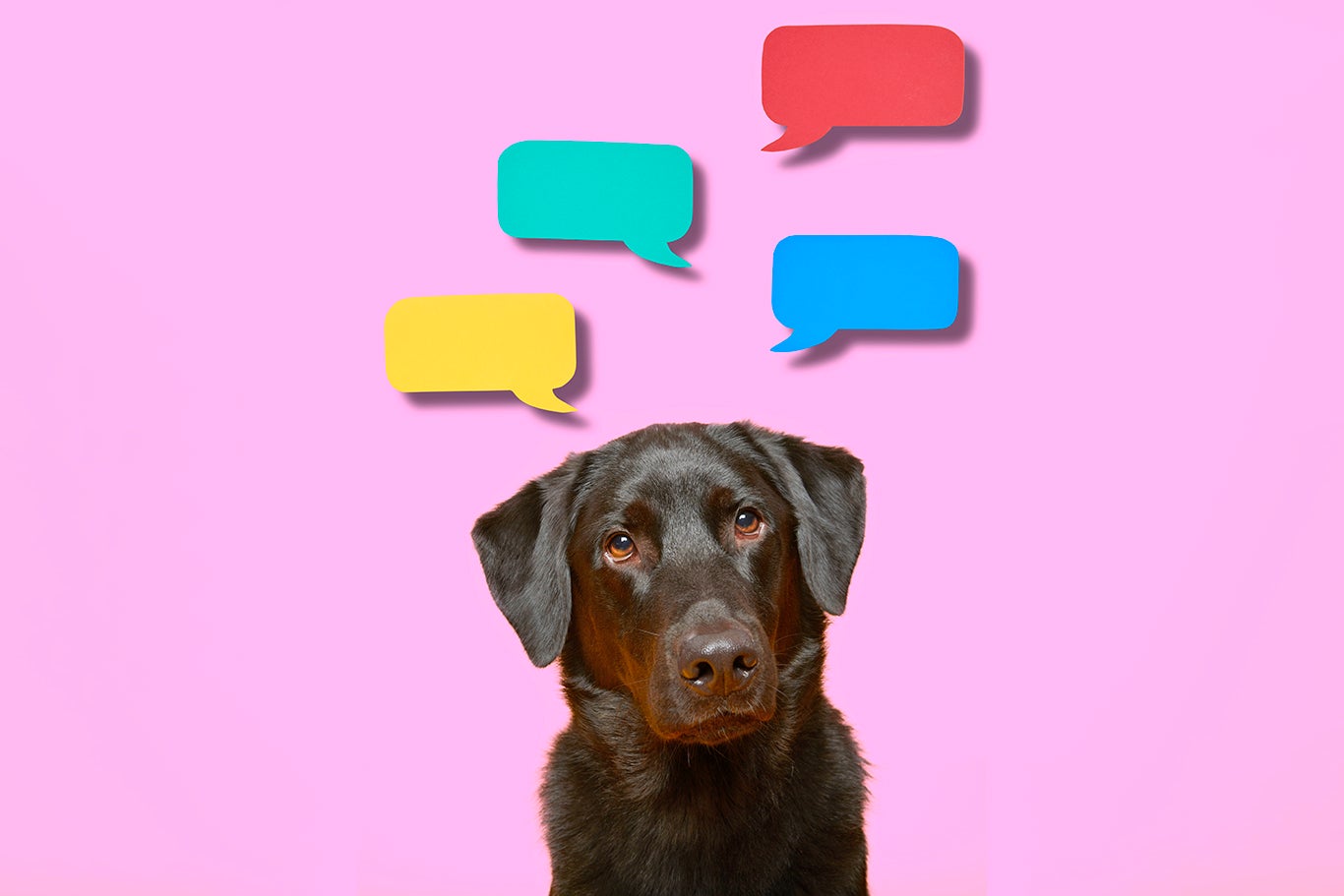
[ad_1]

Dogs are constant sidekicks for humans, and they’re usually pretty good at letting us know what they want: a tail-wagging dance by the front door means it’s time for a walk, and a heavy head on your lap suggests that someone needs scratches.
Some owners are going further to communicate with their pets. For anywhere from $20 to more than $200, dog-loving humans can purchase paw-friendly buttons, each representing a word such as “walk” or “play,” to give their pet a voice. On TikTok, some of these “button dogs” seem to be doing surprisingly intelligent things, such as combining two words to create a unique meaning—“squeaker” and “car,” to refer to an ambulance, for example. One of the more famous members of this doggie bunch on TikTok, a sheepadoodle named Bunny, can apparently put together four-word phrases. In one instance, for example, she pushed buttons to refer to her friend: “Tenrec, come, look, play.”
But can dogs really use language in this way? Canine cognition experts are cautious to downright skeptical at the idea of dogs coming up with novel word combinations. Pups are capable of learning words, however, they say. There are limits, of course. While a few “genius” dogs have been trained to learn hundreds of words, most seem to top out at fewer than a dozen.
“I like that it’s making people interact with their dogs more in a richer way,” says Amritha Mallikarjun, a postdoctoral researcher at the University of Pennsylvania School of Veterinary Medicine, about the use of dog communication buttons. “But they just can’t speak in the way humans can speak.”
Neuroscience studies suggest our canine pals have coevolved to attend to and understand our communication cues. A study of eight-week-old puppies in a service dog program found that even at this early age, puppies attend to human faces, voices and gestures. In the study, published in Current Biology in 2021, the pups picked up on the meaning of pointing from the very first try. That’s a stark contrast to animals closely related to humans, such as chimpanzees, which can learn to care about pointing after being trained but don’t follow human gestures spontaneously, says Emily Bray, now an assistant professor at the University of Arizona’s College of Veterinary Medicine, who co-authored the 2021 study.
“You can train them over hundreds of trials, but it’s not, like, a natural thing,” Bray says of nonhuman primates. “Whereas in the dogs, literally from the first trial, you’re seeing above-chance performance.”
Dogs’ use of communication cues isn’t quite like humans’, though. In her research, Boston College psychologist Angie Johnston compares how dogs and young children learn socially. She’s found that dogs are more likely than little kids to ignore social communication that doesn’t help them reach their goal, suggesting that unlike children, canines are more motivated by communication for practical reasons. “Their way of interpreting communication is pretty different from humans in some ways,” Johnston says.
Brain imaging research published in 2022 revealed that dogs can distinguish between natural and scrambled speech and between familiar and unfamiliar languages. A separate 2022 study found that the animals can distinguish between English and Spanish; canine participants listened longer to the language they weren’t familiar with. This is the opposite of what human babies do, says Mallikarjun, who co-authored the latter study. Human infants tend to pay more attention to their native language.
“Human infants want to listen to their language so they can learn it,” Mallikarjun says, “and dogs are listening [to the unfamiliar language] because it sounds cool.”
Dogs can also pick their names out from a background babble, Mallikarjun and her colleagues have found, though they seem to struggle to differentiate some sounds that humans find easy. They also seem to recognize when a vowel sound has been swapped out in their name, Mallikarjun says, but they can’t always tell the difference when a consonant sound is switched. (In other words, you could call a pup named Bella “Tella,” and she probably wouldn’t notice.)
Bray and her colleagues found that about half of the variation in attention to human communication among the animals is heritable. Dogs that are interested in social interaction with humans tend to have puppies that are similarly motivated, and variation can occur even within a breed. A few famous dogs stand snout and shoulders above the rest in terms of language learning. In a 2004 study scientists trained a border collie named Rico to learn more than 200 words for separate objects; Rico could identify his toys by name and bring his owners the correct one when asked. In 2011 another border collie named Chaser blew Rico’s record out of the water by learning more than 1,000 words over the course of three years.
But whether dogs can learn words for more abstract concepts and whether the average house pet can communicate in a more complex way remain controversial questions. Chaser showed some hints of understanding syntax—she was able to distinguish “bring the sock to the ball” and “bring the ball to the sock,” Johnston says—but it’s not clear if most pets can manage that. University of California, San Diego, cognitive scientist Federico Rossano and his colleagues have launched a large study to try to answer these questions. Using data from button-pushing dogs, the team is studying how well the average pup seems to learn new words, whether there are differences in breeds and if other factors matter, such as when a dog starts training or if there are other animals in the house.
There’s a long history of language research with animals, Rossano says, which has often gone badly. In the 1970s and 1980s, for example, several experiments attempted to take chimpanzees and other great apes and integrate them into human households to see if they could learn language. Reports of the primates generating new language were often anecdotal and poorly documented. After the experiments, many of these primates were returned to primate research centers, where they struggled to adapt and often became violent or depressed.
For the button dog study, the researchers are focusing on animals that are already living with humans as pets, Rossano says. They now have more than 10,000 participants in 47 countries, and round-the-clock cameras are on some of the top performers in order to extensively document their button-pushing communication attempts. (The researchers have a data-sharing agreement with the pet button company FluentPet but do not take funding from it.)
“All research that has been done with dogs is about comprehension,” Rossano says. This is the first large study about dog language production: Can they use buttons in a wordlike manner?
So far, the researchers are still analyzing their data and have not yet published any findings in a peer-reviewed journal. Unsurprisingly, given pets’ ability to learn commands, the early data suggest that most pups can learn to associate words with some sort of meaning; they know that pushing a button for “play” will get them attention, for example. Some dogs in the study seem to be able to use 40 to 50 buttons, Rossano says, while five or six have learned more than 100. The median number of words learned, however, is nine.
Researchers in Hungary have also found that a select number of animals can learn a lot of words. Their worldwide Genius Dog Challenge, a scientific attempt to find gifted canines capable of being trained to learn language, had turned up about 40 such pups as of early 2023, according to Andrea Sommese, an animal cognition researcher at Eötvös Loránd University in Hungary, who is part of that project. “It’s a very, very unique talent,” Sommese says.
The reports of dogs being able to put together words in new and creative ways (a talent called generative language) are, so far, anecdotal, Rossano says. Some of the videos online look amazing, Johnston says, but it’s hard to tell whether they’re cherry-picked examples in which a pup has picked meaningful-seeming words by chance.
“The problem is that there is a lot of confirmation bias,” Mallikarjun says. “We desperately want them to be saying something to us.”
Rossano believes generative language might be possible for some dogs but says it will require carefully controlled research to be proved.
“For me, that’s the big goal: ‘Is this more than just basic associative learning?’” he says. “Is this something that reveals, somehow, the existence of a mind that is more complex than we give them credit for?”
[ad_2]